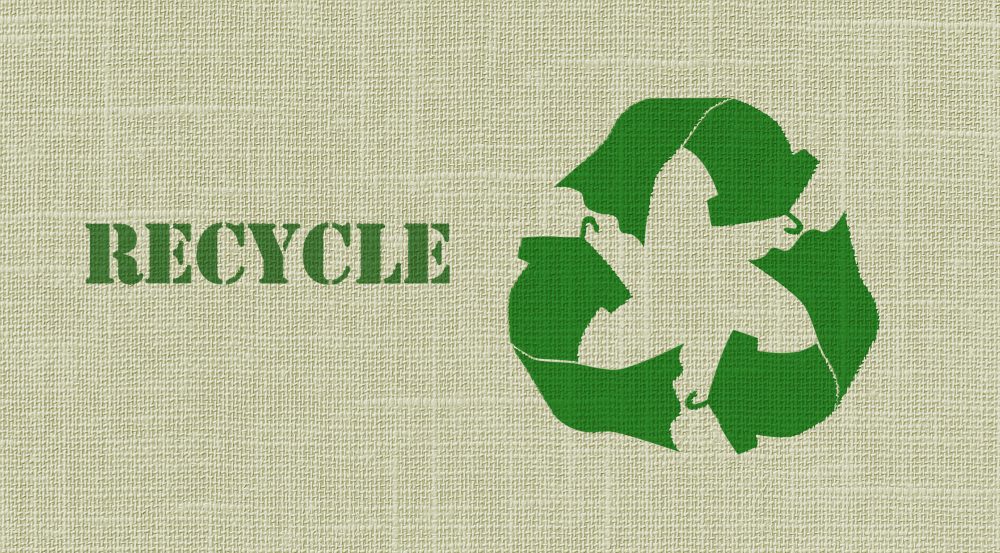
Polyester or nylon yarn: which should you choose? The best yarn for your application will be determined by a wide range of factors; the following FAQ should answer any questions you may have.
Can I recycle polyester and nylon yarns?
Both polyester and nylon yarns can be recycled, and yarns are available with recycled polyester and nylon components; ECOTEC® by Marchi & Fildi is an example of a brand that incorporates recycled polyester and nylon in its spun yarns. Recycling polyester and nylon yarns can be done with two methods.
The first is to melt the yarns down and turn them into chips. This can be done in order to essentially process the polymer from scratch, meaning that it can be extruded again to make a new yarn, or be used in any other polyester or nylon product. This can be an expensive and difficult process; depending on the base polymer used, the melting may have to occur in an oxygen-free atmosphere.
The second option is to break the yarn filaments into short staple fibres and spin them like any other staple fibre. Tay also offers yarns that have been recycled using this process.
Polyester vs nylon yarn: which is stronger?
Yarn tenacity is highly dependent on the post-extrusion processing techniques like twisting, plying and cabling. It is also affected by the specific polyester or nylon that is being discussed. Nonetheless, some generalisations can be made about polyester and nylon yarn tenacity, using PET (polyester terephthalate) and Nylon 66 as examples.
Nylon tenacity is higher than that of polyester, meaning that for the same weight/unit length, nylon can withstand a higher tensile load. However, given polyester’s higher density, a polyester yarn of equal thickness to a nylon yarn would have a higher tensile strength. This means that when maintaining low weight is a priority, nylon is the yarn to choose for higher tensile strength, whereas polyester is the best choice when a finer yarn is required.
Can I dye polyester and nylon?
Polyester and nylon yarns have different dyeing properties. Dope dyeing is an option for both polyester and nylon, along with other yarn dyeing techniques. Polyester yarns require disperse dyes, while nylon requires weak acid-based dyes. While both can be dyed, dyed polyester is more durable and resistant to prolonged heat compared to nylon, which will fade. While polyester requires heating around 130°C in order to open the fibres for the dye to stick, nylon requires heating to only 90°C-100°C.
How do polyester and nylon feel in the hand?
How polyester and nylon yarns feel in the hand is highly dependent on whether they are spun, monofilament, or multifilament. Generally, spun yarns will feel soft in the hand, whatever material is used. The differences are more noticeable in multifilament yarns.
Nylon is generally regarded as the softer yarn, as it was developed as a silk alternative. The production process for polyester has improved substantially, so polyester yarn is quite soft although still not quite as much as nylon. Nylon yarns in particular can have issues when sewing and weaving as a result of their slipperiness, but this can be fixed by twisting the yarn; sewing threads are often made by plying three threads in one direction, and two threads of that yarn in the opposite direction, to produce a more grippy and balanced thread.
Polyester and nylon multifilament threads can also be textured in order to change their feel through techniques like entangling with high pressure air or crimping with heat and pressure. This can be particularly useful when using polyester and nylon in textiles where the feel and appearance of the product is important.
Should I use polyester or nylon outside?
Polyester is the best choice when choosing a material to expose to the elements – water and UV light can degrade nylon faster than polyester. Polyethylene terephthalate, a type of polyester, is somewhat susceptible to UV rays, however. This is the first reason why polyester is the yarn of choice for outdoor fabrics and ropes.
Nylon is significantly more water absorbent than polyester and elongates by 3.5% and absorbs up to 4% of its weight in water, compared to just 0.4% for polyester. As with UV stability, water absorption is a concern for nylon yarns that are used outside, as the water absorption and elongation can deform the fabrics and ropes made from the nylon yarns. For these reasons, polyesters are the favoured choice for yarn that must weather the outdoors.
Does polyester or nylon provide more chemical resistance?
Polyester and nylon are each highly resistant to some chemicals, while highly susceptible to others. Polyester is highly resistant to acids, oils and solvents, while nylon is highly resistance to alkalis and oils. However, polyester is far less susceptible to many chemicals than nylon; polyester is only susceptible to alkaline substances, whereas nylon is susceptible to acids, oxidisers like hydrogen peroxide, and alcohols. While these concerns may be less important when deciding which yarn to use to make a fabric garment, these characteristics are vital to understand when using yarns in an industrial setting.
Is polyester or nylon more elastic?
Nylon is more elastic than polyester. In addition to nylon’s higher tenacity, its higher elasticity makes it a preferred yarn for parachute chords. The elasticity of any given yarn is affected by the twist level on it; a yarn with a higher twist level will be less elastic than an otherwise identical one with a lower twist level.
Is polyester or nylon more resistant to abrasion?
Both polyester and nylon offer excellent abrasion resistance, but nylon exhibits higher abrasion resistance than polyester, meaning that it is likely to take longer to abrade. Abrasion resistance is particularly important in fabrics that are designed to last a long time or provide protection to the user of the yarn.
Shoes and furniture are good examples of items that require fabrics that exhibit excellent abrasion resistance; high tenacity is insufficient, as the constant movement and high loads that shoes and furniture like seats receive would wear down a weak fabric quite quickly. Protective clothing like motorcycle jackets and gloves are often made from nylon as the nylon offers good protection from road burn.
While polyester also offers good protection in these applications, the extra abrasion resistance afforded by nylon is often worthwhile. The best protective equipment will include aramids like Kevlar, but the extra cost may be prohibitive.
The SageZander team is here to help, so if you are looking for polyester yarns or nylon yarns, please don’t hesitate to contact us on +44 (0)1260 295264 and sales@sagezander.com.

